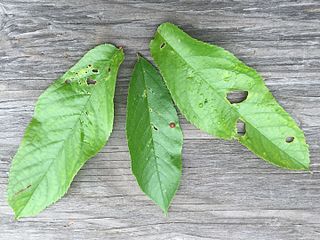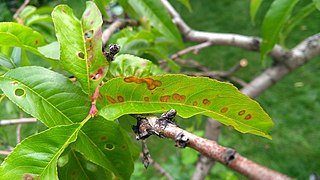Found mainly on the Prunus family, shot hole disease affects fruit trees including plum, peach, apricot, and cherry varieties. It’s often mistaken as the work of an insect but instead, it’s caused by shot hole fungus. It can affect fruiting and ornamental trees and displays in the forms of holes in the leaves, uneven surfaces on fruit, and deformities on the branches.

Gypsypitcrew, CC BY-SA 4.0, via Wikimedia Commons

CoolKoon, CC BY-SA 4.0 , via Wikimedia Commons
Jump To...
What Causes Shot Hole Disease?
Shot hole disease is a fungal infection which affects stone fruits. It is caused by the pathogen Stigmina carpophila.
When the infection takes a firm hold, leaves will begin to fall off the tree. In serious cases, fruit production will be severely hindered.
The spores of this disease are spread through moisture and spread well during rainy weather. Severe instances of shot hole hinder the photosynthesis process.
Shot Hole Disease Symptoms
At first glance, you may mistake shot hole infection for insect damage. In the early stages, it can be difficult to accurately identify the symptoms.
However, when you take a closer look you will be able to determine quickly if your tree is infected with shot hole disease. Use this checklist to try and identify if your fruit tree is suffering from this fungal infection.
Symptoms On The Fruit Tree:
- Symptoms begin with red or brown spots with a yellowish ring around them on the leaves themselves.
- As the disease takes hold, the infected parts of the leaves fall away, leaving “BB” sized holes behind.
- As shot hole disease spreads, the leaves will continue to see damage until they fall off.
- Infected fruit may have purple spots on them that will turn into white lesions. There will be rough areas to the fruit as well.
- Branches can become diseased and weakened and infected buds may appear darker in colour compared to healthy ones.
Shot Hole Disease Treatment & Control
Rain and moisture causes shot hole disease to spread quickly so the quicker you take action, the less damage there will be.
Prolonged wet periods will accelerate this disease so be mindful of checking after particularly wet weather. Damage from Shot Hole Disease will be most noticeable in the spring months, so keep a watchful eye on your fruit trees.
Pruning & Orchard Hygiene
Treatment of shot hole disease can be achieved through a combination of good orchard hygiene, and immediate pruning of any leaves and branches showing signs of infection.
The best cure for shot hole is prevention, if you regularly prune and monitor your fruit trees you will keep them healthier. It’s particularly important to monitor your trees after prolonged wet spells.
- Regular pruning of weak branches and shoots can help keep this disease at bay. Any infected leaves and branches should be immediately removed and destroyed.
- Overhead watering should be avoided as this encourages the disease to spread more quickly.
- Being aware that spores travel through moisture can help you observe any potential symptoms.
- Regularly check the leaves for brown or red circles or BB-sized holes.
- Try to sterilise your pruning equipment after each use.
Treating Shot Hole Disease with Anti Fungal Sprays
Once shot hole is firmly established, using a fungal spray to kill off the spores will be necessary.
If using chemicals is a concern, there are several organic alternatives available on the market.
- Treatment is most effective when the new shoots are appearing.
- There are also sprays you can use other times of the year which will act as a preventative.
Biology & Lifecycle
Shot hole is spread through environmental conditions – particularly when you bring together warm and wet conditions.
Young trees are most susceptible to this bacterial or fungus infection, the older the tree gets the less this problem should occur.
Infected spores can lie dormant for many months until conditions are right. When the weather warms up and water droplets remain on leaves, you can witness a fast spread of this disease.




